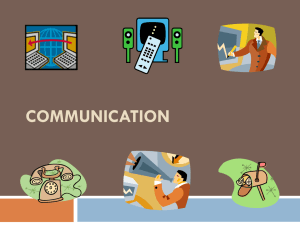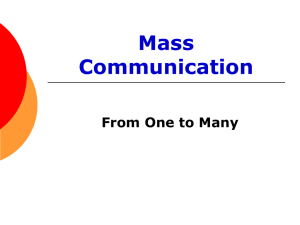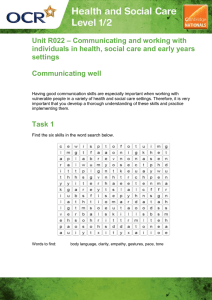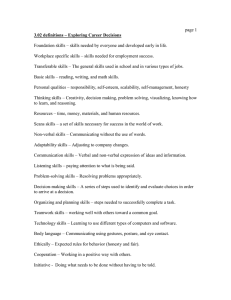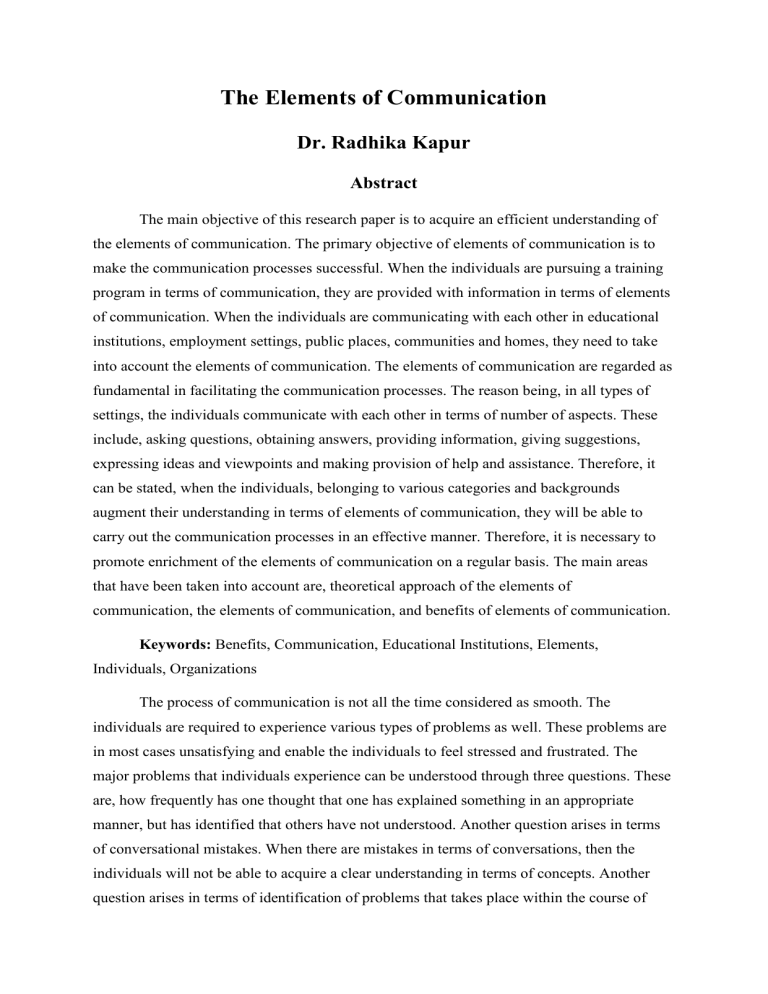
The Elements of Communication Dr. Radhika Kapur Abstract The main objective of this research paper is to acquire an efficient understanding of the elements of communication. The primary objective of elements of communication is to make the communication processes successful. When the individuals are pursuing a training program in terms of communication, they are provided with information in terms of elements of communication. When the individuals are communicating with each other in educational institutions, employment settings, public places, communities and homes, they need to take into account the elements of communication. The elements of communication are regarded as fundamental in facilitating the communication processes. The reason being, in all types of settings, the individuals communicate with each other in terms of number of aspects. These include, asking questions, obtaining answers, providing information, giving suggestions, expressing ideas and viewpoints and making provision of help and assistance. Therefore, it can be stated, when the individuals, belonging to various categories and backgrounds augment their understanding in terms of elements of communication, they will be able to carry out the communication processes in an effective manner. Therefore, it is necessary to promote enrichment of the elements of communication on a regular basis. The main areas that have been taken into account are, theoretical approach of the elements of communication, the elements of communication, and benefits of elements of communication. Keywords: Benefits, Communication, Educational Institutions, Elements, Individuals, Organizations The process of communication is not all the time considered as smooth. The individuals are required to experience various types of problems as well. These problems are in most cases unsatisfying and enable the individuals to feel stressed and frustrated. The major problems that individuals experience can be understood through three questions. These are, how frequently has one thought that one has explained something in an appropriate manner, but has identified that others have not understood. Another question arises in terms of conversational mistakes. When there are mistakes in terms of conversations, then the individuals will not be able to acquire a clear understanding in terms of concepts. Another question arises in terms of identification of problems that takes place within the course of communication processes. The individuals need to be aware of the causes of problems. Therefore, through the elements of communication, the individuals are able to augment their understanding in terms of ways that are essential to promote effective communication (Chapter 2. Elements of Communication, n.d.). The individuals are different from each other in terms of number of aspects. These include, personality traits, natures, attitudes, competencies, educational qualifications, occupations and learning abilities. In some cases, individuals are well-aware in terms of information that is imparted to them, whereas, in other cases, they may not understand the information in one attempt and the senders are required to reiterate the concepts. Therefore, it is vital to put into operation various kinds of methods and approaches in communicating with other individuals. Furthermore, it needs to be understood that not all words mean the same thing to all the other individuals. The individuals usually bring about changes in the environmental conditions and personality traits from time to time. Hence, they also need to bring about changes in their communication skills. Through acquiring an efficient understanding of the elements of communication, the individuals are able to generate awareness in terms of how to promote changes that would be favourable and meaningful. Therefore, the elements of communication are regarded as significant and noteworthy. Theoretical Approach of the Elements of Communication Getting engaged in effective communication processes is regarded as an element of art and science. When research is conducted in terms of the communication processes, it is essential for the individuals to develop a structure of elements of communication. When the individuals develop the structure in terms of the elements of communication, they are able to understand that in order to carry out the communication processes in an effective manner and generate the desired outcomes, it is indispensable to augment one’s understanding in terms of the elements. The important elements of communication are, verbal messages, non-verbal messages, clarity of thought and expression, precision and appropriateness, conciseness, conducive environment, channel, feedback, completeness and context. These elements enable the individuals to acquire a satisfactory understanding in terms of the ways in which communication processes can be put into operation in a well-organized and agreeable manner. The elements render a significant contribution in helping the individuals to make the communication processes successful and in achieving the desired goals and objectives. The elements of communication are regarded as distinguished products in the field of communication (Udemy, 2020). When the individuals are conducting research on communication or are pursuing educational programs in communication, then taking into account the elements of communication is regarded to be of utmost significance. The first and the foremost question that arises is, why and how the processes of communication needs to be put into operation, so they prove to be beneficial to the senders as well as receivers. When the senders are imparting information, they need to ensure that the receivers understand it well. Whereas, when the receivers are receiving information, they need to ensure that they are able to provide solutions to all their problems. Hence, the theoretical approach of the elements of communication contribute in imparting the necessary and valuable information to the senders and receivers in terms of communication processes. The Elements of Communication As it is comprehensively understood that individuals are making use of technologies to a major extent in communicating with others. But the effective use of technologies do not guarantee effective communication. In other words, it is not guaranteed that when the individuals will make use of various types of technologies and innovative methods, they will communicate with each other in an effective manner. With the advent of modernization and globalization and with advancements taking place, the senders need to ensure that they put into operation the communication processes in accordance to the needs and requirements of the receivers and keep pace with the changes taking place (Akilandeswari, Kumar, Pavithra, Mariyam & Banu, 2015). However, there are various elements in the communication processes, which need to be taken into account. These are stated as follows: Verbal Messages - Verbal messages are referred to the use of sounds and words that are used to express oneself, particularly in contrast to the use of gestures and mannerisms. In the implementation of this element of communication, both the senders and receivers participate in the implementation of communication processes. Verbal messages are important as they are regarded as the key in the maintenance of successful terms and relationships among individuals. Verbal messages are the use of words to share information with other individuals. It includes both spoken as well as written forms of communication. However, there are number of individuals, who make use of this term to describe only spoken communication. The verbal element of communication is regarding the words, which are spoken. In this element, there are various aspects, which need to be taken into consideration. These include, speaking clearly and fluently, listening, making use of decent words and communicating in a friendly manner. When the individuals put into practice these aspects in an appropriate manner, they are able to enhance this element of communication (Verbal Communication Skills, 2020). Non-Verbal Messages – Non-verbal messages is the transmission of messages or signals through non-verbal means. These include, eye contact, facial expressions, gestures, postures and body language. Making use of these means can give clues and additional information and meaning over and above verbal communication. Non-verbal messages have been regarded as significant and meaningful to the individuals in number of ways. These include, reinforcing or modifying what has been specified in words, conveying information in terms of their emotional state, describing and strengthening the terms and relationships among individuals, providing feedback to others and regulating the flow of information. Nonverbal messages are conscious as well as unconscious. The reason being, it is usually difficult for the individuals to control facial expressions, because one cannot see oneself to know what they are doing. The individuals may complicate the communication processes by making an attempt to convey one message consciously and another unconsciously. Furthermore, it is vital to understand that handwriting clues can also signify how one is feeling (Non-Verbal Communication, 2020). Therefore, it can be stated, non-verbal messages are important elements of communication. Clarity of Thought and Expression – The senders of the information need to be wellaware of the concepts and other information that they need to impart to the receivers. Another important aspect is, they need to be aware in terms of purpose. Communication usually takes place among individuals, when they have a purpose. The individuals make sure that they implement the communication processes in such a manner that they are able to achieve the purpose. The individuals need to think before they speak. Thinking before speaking is an important strategy that facilitates in the development of clarity of thought and expression and achievement of goals of communication. Clarity of thought and expression is central to effective communication. When one will be able to think clearly, they will be able to express themselves clearly. One should not think that communication processes can be carried out spontaneously. One has to put it into operation and clarity of thought and expression is regarded as indispensable. Therefore, it is considered as an important element of communication (Akilandeswari, Kumar, Pavithra, Mariyam & Banu, 2015). Precision and Appropriateness – The elements of precision and appropriateness are regarded as vital in terms of message. The message, which the senders are conveying to the receivers of information should be correct, precise and appropriate. When one is conveying the message in a verbal manner, they need to ensure, they speak clearly, fluently and truth. On the other hand, when the individuals are communicating with others in a written form, they need to ensure, they impart factual information and there should not be grammatical errors and spelling mistakes. When the individuals, particularly in educational institutions and organizations are communicating with each other in terms of statistical data, facts and information, they need to ensure that they are imparting the truth. The elements of precision and appropriateness are regarded as significant in not only educational institutions and organizations, but in other places as well. When the individuals are communicating with each other within homes, financial institutions, marketplaces and in other public places, then also these elements need to be taken into consideration. Conciseness – The message should be concise. There are various reasons that signify the meaning of this element. When the message is concise, the senders are able to deliver it well through different sources, the receivers are able to understand it in an appropriate manner and it leads to alleviation of any kind of perplexity. The concise message not only imparts information that is important, but also the individuals are able to implement clarity of thought and expression. This element normally is put into operation on the basis of concepts, and subjects of communication. When the individuals feel that they are to impart information to others in terms of topics, which are lengthy, then they would not take into account the element of conciseness. On the other hand, when the topics require the senders to impart messages, which do not comprise of large amount of information, then the element of conciseness is taken into account. The individuals are required to convey all kinds of information, lengthy as well as brief. Therefore, it is vital for the individuals to acquire an efficient understanding of this element when imparting information. Conducive Environment – Research studies have indicated that it is vital for the individuals to create a conducive environment in order to carry out the communication processes in an effective manner. The conducive environment is characterised by implementing the methods and approaches that are favourable, encouraging, and advantageous to the individuals. When the environmental conditions are favourable and contain all the essentials that are necessary to promote effective communication and carry out ones tasks and activities in a well-organized manner, then the individuals are able to augment their learning and understanding. In order to create a conducive environment, there are various factors, which need to be taken into consideration. These include, providing the necessary infrastructure, amenities and facilities, there should be heating and cooling equipment in accordance to the weather conditions, and technologies, materials and tools that are needed in the implementation of job duties. All the members, employed in various types of organizations and educational institutions of all levels need to be well-aware and put into operation the methods and strategies that would contribute in the formation of conducive environment. Channel – Communication channel is referred to as the medium, mean, manner or method, through which the message is imparted by the senders to the receivers. The communication channels include, physical transmission medium such as, wire, or logical connection through a medium, which includes radio channel in the communication processes, telecommunications, computer networking, electronics, technologies and multimedia. The channels need to be suitable in accordance to the needs and requirements of the senders as well as the receivers. In order to ensure that information is imparted to the receivers in an appropriate manner, it is vital to make selection of appropriate channels. Communication channels lead to flow of information among individuals in terms of particular topic, concept or factor or among organizations. In organizations, and when individuals are located at a distance, there are comprehensive utilization of technologies in communicating. Implementation of appropriate communication channels within the organization is regarded to be of utmost significance in keeping the employees engaged, aligned and help them to be more productive (Top Communication Channels, 2019). Therefore, it can be stated that implementation of appropriate channels contributes in promoting willingness and interest in communicating. Feedback – Feedback is an element of communication that is put into practice by the teachers, instructors, supervisors, managers, employers, heads, directors and so forth in various educational institutions and organizations. In educational institutions, the instructors implement various types of assessment methods in order to evaluate the performance of the students after information has been imparted to them in terms of lesson plans and academic concepts. The various types of assessment methods include, assignments, projects, tests, competitions, quizzes etc. After the students have participated, the instructors evaluate their performance and give them feedback. On the other hand, in various types of organizations as well, the supervisors and managers put into operation assessment methods to evaluate the performance of the employees and give feedback. Obtaining feedback enables the individuals to identify the limitations. After they have identified the limitations, they implement the ways to bring about improvements and achieve the desired outcomes. When feedback is given, it is vital to give it in a constructive manner. As constructive feedback will help in development of motivation towards work. Therefore, feedback is regarded as an important element of communication. Completeness – The element of completeness is regarded as crucial because it enables the individuals to understand that communication intends to create meaning and understanding. When information is imparted to other individuals, it is vital to ensure that it is comprehensive. Completeness in information helps in alleviating incompleteness and the individuals are able to augment their understanding in terms of various aspects. Completeness in information is more likely to generate the desired outcomes. The individuals are able to fulfil the purpose of communication satisfactorily. The individuals, belonging to various categories and backgrounds have the main objective of promoting well-being and goodwill. In order to achieve these traits, it is vital for them to ensure that the element of completeness is put into operation in the communication processes. Complete information needs to be conveyed to other individuals in all fields, i.e. medical, education, law, engineering, management, administration and so forth. The individuals in leadership positions are the ones, who need to put it into practice throughout their jobs. Therefore, it is regarded as an important element of communication and helps in achieving professional goals and objectives. Context – Context refers to the setting in which communication takes place. The context helps in establishing the meaning and has an impact on what is stated and how it is stated. Context is classified into four types, physical context, cultural context, socialpsychological context and temporal context. The physical context refers to the concrete environment, i.e. workplace, park, home etc. Every place has its own rules, which influence the communication processes. The cultural context refers to the values, norms, beliefs and lifestyle of the individuals. These traits influence, whether something that has been said is appropriate or inappropriate. The socio-psychological context takes into consideration the norms of the group in a particular situation. There are certain rules, which need to be followed in order to communicate efficiently. The temporal context is referred to as the positioning of the message within the sequence of conversational events. It administers the framework of the conversations and how the topics are to be addressed and related thereafter (The Basics of Human Communication, n.d.). Therefore, context is regarded as an indispensable element of communication, which enables the individuals to take into account the essential attributes. Benefits of Elements of Communication The elements of communication are regarded as important and there are number of benefits. Communication takes place between two or more individuals, which are senders, who are imparting information and the receivers, who are receiving information. The elements of communication also imparts understanding among the individuals that they need to adequately take into account the aspects of, verbal messages, non-verbal messages, clarity of thought and expression, precision and appropriateness, conciseness, conducive environment, channel, feedback, completeness and context. The benefits of elements of communication are stated as follows: Understanding Viewpoints and Perspectives – When the individuals are communicating with each other through verbal or non-verbal means, they are able to understand each other’s viewpoints and perspectives. Provided the individuals take into account all the factors that are needed for effective communication. When the individuals are seeking ideas and suggestions from others in providing solutions to their problems, then they need to ensure that communication processes take place in such a manner that they are able to understand appropriately, what others are conveying. Therefore, when the individuals generate awareness in terms of elements of communication, they are able to understand each other’s viewpoints and perspectives. Bringing about Improvements – Within educational institutions, various kinds of employment settings and in the implementation of other tasks and activities, when the individuals experience limitations and setbacks, they need to put into operation the strategies and methods to bring about improvements. One of the effective ways of bringing about improvements is communicating with knowledgeable and experienced individuals. When the individuals put into operation the elements of communication in an appropriate manner, they will be able to communicate well in terms of their problems and bring about improvements. Therefore, it can be stated that bringing about improvements is also regarded as an important benefit of elements of communication. Generating Awareness – It is comprehensively understood that to sustain one’s living conditions in a satisfactory manner, it is essential for the individuals to generate awareness in terms of various aspects. Communicating well with others also renders a significant contribution in generating awareness among the individuals in terms of number of factors. When the individuals are getting engaged in formal conversations with individuals, particularly in educational institutions and employment settings, they need to ensure they take into consideration all the elements of communication to augment their understanding and generate awareness in terms of particular topics. Therefore, generating awareness is regarded as one of the important benefits of elements of communication. Generating the Desired Outcomes – Generating the desired outcome and achievement of personal and professional goals are important aspects that need to be taken into account by the individuals, irrespective of categories and backgrounds. In order to generate the desired outcomes and in the achievement of personal and professional goals, it is indispensable for the individuals to get engaged in effective communication with others. It is comprehensively understood that effective communication is regarded as fundamental that renders a significant contribution in generating the desired outcomes. Therefore, it can be stated that generating the desired outcomes is regarded as an indispensable benefit of the elements of communication. Promoting Effective Terms and Relationships with Others – One cannot carry out one’s tasks and functions in isolation. In order to generate the desired outcomes and sustain one’s living conditions in a well-organized manner, it is vital for the individuals to promote effective terms and relationships with others within as well as outside the homes. In order to promote effective terms and relationships with others, it is necessary to understand and put into operation the elements of communication. When the individuals promote effective terms and relationships with others, they are able to enrich their lives. Therefore, this benefit is acknowledged to a major extent. Promoting Co-ordination and Integration – In some cases, there are certain tasks and functions, which are carried out by the individuals on their own and they do not have to obtain support and assistance from others. On the other hand, there are tasks and activities, which require the individuals to work in co-ordination and integration with others. The elements of communication enable the individuals to recognize the importance of coordination and integration. When the individuals are working in co-ordination and integration with others, they are able to provide solutions to their problems and carry out their job duties well. Therefore, this benefit is acknowledged to a major extent. Making Effective Decisions – Decision making is an integral part of the lives of the individuals. Within various types of organizations and educational institutions, making of effective decisions are regarded as significant in leading to their functioning. The individuals need to make wise and meaningful decisions, which would prove to be beneficial to others as well as organization as a whole. The decisions need to be lucrative. When the individuals are well-aware in terms of elements of communication, they are able to make meaningful and effective decisions. In the making of decisions, the individuals usually are required to obtain ideas and suggestions from others. Therefore, they need to put into operation the communication processes. The elements of communication contribute well in making effective decisions. Increase Managerial Efficiency – Every individual within the organization is assigned tasks and functions. The individuals are required to carry out their tasks and activities in accordance to their educational qualifications, competencies and abilities. They are responsible for their job duties. But to perform their job duties in a well-organized manner and incur the feeling of job satisfaction, it is vital for the individuals to lead to an increase in managerial efficiency. Increase in managerial efficiency is due to implementation of elements of communication. Therefore, one of the major benefits of elements of communication is, it leads to increase in managerial efficiency. Establish Efficient Leadership – The individuals in educational institutions and organizations, who are directors, heads, supervisors, managers etc. are required to hone their leadership skills on regular basis. Through the establishment of efficient leadership, the individuals will be able to adequately guide and lead the employees in the direction, help them to achieve their goals and provide solutions to their problems. Elements of communication help the individuals to augment their understanding and generate awareness in terms of how to implement the leadership traits in an efficient manner. When they will communicate well with others, only then they will be able to establish efficient leadership. Therefore, establishment of efficient leadership is regarded as one of the indispensable benefits of elements of communication. Increase Motivation and Employee Morale – It is vital for the individuals, who are in leadership positions to lead to an increase in motivation and employee morale. Motivation is referred to development of willingness to carry out tasks and activities. Increase in motivation and employee morale is regarded to be of utmost significance, as they enable the employees to form positive viewpoints and develop interest and enthusiasm towards the implementation of job duties. Furthermore, their mind-sets gets stimulated towards the implementation of their job duties in accordance to the expectations of their employers. When the approaches and strategies will be formulated to increase motivation and employee morale, they need to be communicated to others in an appropriate manner. Hence, it is vital for the individuals to take into account the elements of communication. Therefore, increase in motivation and employee morale is also regarded as one of the indispensable benefits of elements of communication. Conclusion When the individuals are acquiring an understanding of the elements of communication, they are able to understand that in order to carry out the communication processes in an effective manner and generate the desired outcomes, it is indispensable to augment one’s knowledge in terms of the elements. The important elements of communication are, verbal messages, non-verbal messages, clarity of thought and expression, precision and appropriateness, conciseness, conducive environment, channel, feedback, completeness and context. The benefits of elements of communication are, understanding viewpoints and perspectives, bringing about improvements, generating awareness, generating the desired outcomes, promoting effective terms and relationships with others, promoting coordination and integration, making effective decisions, increase managerial efficiency, establish efficient leadership, and increase motivation and employee morale. The elements enable the individuals to acquire an efficient understanding in terms of the ways in which communication processes can be put into operation in a well-ordered, efficient and suitable manner. Finally, it can be stated, the elements render a significant contribution in helping the individuals to make the communication processes worthwhile and meaningful. Furthermore, they are able to achieve the desired goals and objectives. Bibliography Akilandeswari, V., Kumar, A.D., Pavithra, M., Mariyam, A.T., & Banu, J.N. (2015). Elements of Effective Communication. International Journal of Multidisciplinary Research and Modern Education, 1(1), 154-156. Retrieved September 11, 2020 from rdmodernresearch.org Chapter 2. (n.d.). Elements of Communication. Retrieved September 11, 2020 from sps186.org Non-Verbal Communication. (2020). Retrieved September 12, 2020 from skillsyouneed.com The Basics of Human Communication. (n.d.). Retrieved September 12, 2020 from humancommkj.weebly.com Top Communication Channels to Consider for your Business. (2019). Retrieved September 12, 2020 from blog.smarp.com Udemy. (Ed.). (2020). The Elements of Communication: A Theoretical Approach. Retrieved September 11, 2020 from udemy.com Verbal Communication Skills. (2020). Retrieved September 12, 2020 from skillsyouneed.com
